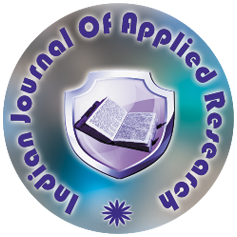Volume : 2, Issue : 8, August - 2013
Isolation ond Identification of A Bacterial Consortium For Biodegradation of a Textile Dye Reactive Orange M2R and Study of Phytotoxicity of the Degraded Product on Phaseolus Mungo and Triticum Aestivum
Jagwani J. S. , Dr. Lakshmi B, Dr. M. C. Sharma
Abstract :
Synthetic dyes are extensively used in textile dyeing, paper, printing, color, photography, pharmaceutics, cosmetics and other industries. Among these, azo dyes represent the largest and most versatile class of synthetic dyes. Traditional methods of treatment are found to be expensive and have operational problems. In the present studies a mixed bacterial consortium (VSS) was isolated from Textile dye contaminated soil and water from Vatva G.I.D.C., Ahmedabad, Gujarat, India, by enrichment culture technique using C.I. Reactive Orange M2R (ROM2R), an azo dye in the Bushnell and Haas Broth (BHB). All six bacterial cultures were identified by 16S rRNA gene analysis and bioinformatics tools. The consortium showed complete decolorization of the selected dye (ROM2R–100 mg/L) within 24 hrs in static conditions. The biodegradation was monitored by UV–Vis spectrophotometric analysis and High Performance Liquid Chromatography (HPLC). The presence of azo reductase suggests its role in the degradation of the dye. The non toxic nature of the degradation metabolites of ROM2R was revealed by phytotoxicity studies on germination and growth of Triticum aestivum and Phaseolus mungo. The results suggest that the isolated consortium VSS as a useful tool to treat waste water containing reactive (azo) dyes.
Keywords :
Article:
Download PDF Journal DOI : 10.15373/2249555XCite This Article:
Jagwani J. S, Dr. Lakshmi B, Dr. M. C. Sharma / Isolation ond Identification of A Bacterial Consortium For Biodegradation of a Textile Dye Reactive Orange M2R and Study of Phytotoxicity of the Degraded Product on Phaseolus Mungo and Triticum Aestivum / Gl


 MENU
MENU

 MENU
MENU

